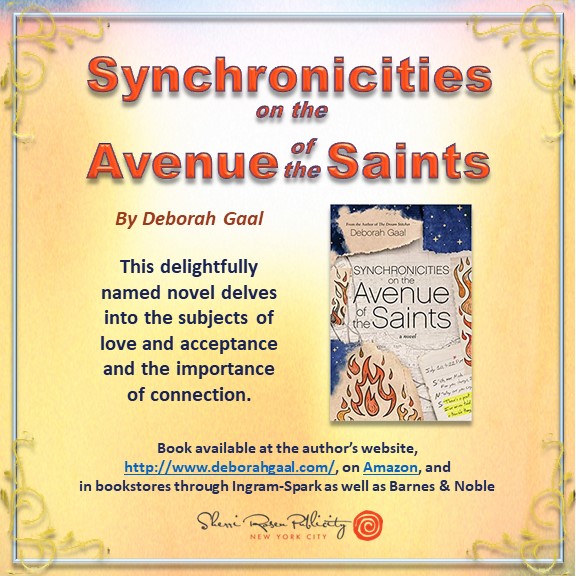Sherri Rosen: What is the book Synchronicities on the Avenue of the Saints about?
Deborah Gaal: In the novel’s prologue a shaman tells a woman she must write a story to please the ancestors.
“What kind of story?” she asks.
The shaman answers, “A story of the indigenous world and modernity coming together to heal the earth. A story of how all people must accept our mutual importance. A story of bad medicine and good medicine.”
This is the theme of the novel, the coming together of modern and indigenous beliefs as a way to cure what ails us. Right now, we could use a little help. Of course, in all great stories there is a plot populated with heroes, and villains.
Sally Friedman runs a pharmaceutical company and uses her company’s resources, along with the help of a psychiatrist to develop a drug to manage her son Noah’s bipolar disorder. Noah, a physicist working to prove the theory that the fifth dimension is awareness, has been on the drug for fourteen years when the story begins, and through his childhood journalist friend meets a shaman who foresees the drug has deadly consequences. Meanwhile, Noah’s dying great-grandmother tells him about a witch from the shtetl in 1918 who has cursed the family because they stole from her rather than following through on a promise. Guided by the shaman, Noah must right his family’s wrong, stop a pharmaceutical kingpin from raiding the family business, halt the global launch of this deadly med, and prove that love creates a synchronicity with what and who is loved.
Sherri: What inspired you to write this novel?
Deborah: Nearly twenty years ago, when one of my family members was struggling with mental illness, I recognized that Western medicine’s approach for a cure—a combination of medication, hospitalization, and talk therapy—wasn’t working. I feared I might lose my loved one, whether it be to drugs, alcohol, suicide, homelessness, or a perpetual state of crazy from which he’d never return.
Adhering to the motto “when things at their darkest, I’m at my best,” I frantically searched out possible treatments. I found an article in an alternative medicine book that described a shaman, Malidoma Patrice Some, who took an 18-year-old bipolar patient to live with his tribe in Burkina Faso. The shaman’s villagers believed that anyone with mental illness was in truth a “healer in the making” who was not attuned to their true purpose, rather their energy was blocked from discovering their destiny. Because of this misalliance, the person’s messages from the spirt world come through as dark, chaotic, and jumbled.
In indigenous cultures, the village understands an individual is a soul in process, and society offers that disconnected person support rather than isolation. In the case of the teenage bipolar patient, he discovered his true gifts as a result of the tribe’s caring. He healed and returned to the United States to attend Harvard and become a doctor.
This story gave me hope. I read the books Of Water and the Spirit, and Ritual written by Dr. Some, who holds a PhD from both the Sorbonne and Brandeis University. In addition, he is an elder of the Dagara Tribe who has been given the mission to spread the teachings of his culture to the wider world. When modernity accepts indigenous teachings, this mutual importance will heal the earth.
When I discovered Dr. Some would be speaking merely a hundred miles from me, I made an appointment and journeyed north to see him. This led to my spending a week with him and his students in the woods of Oregon, where I studied African Indigenous Ritual.
While there, I receive a divination from Malidoma, a session where he read spread runes and delivered messages from The Ancestors. The Ancestors told me I would write a novel. “Your story is on fire.” Synchronicities on the Avenue of the Saints is that story.
My sessions and learnings of indigenous culture taught me to let go of the process of trying to heal my family member. It wasn’t my job, and worry was unhelpful. He might heal if I didn’t hold on so tight. “Let the Ancestors do it.”
We are surrounded by ancestors who want to assist in our healing. My job was to release and trust that my family member would come into alliance with his purpose when the timing was right. The process of letting go and trusting was as much my work as his. Mental illness is a family disease, a tight web where we are truly “all in this together.”
Sherri: Where does the title come from?
Deborah: Part of the novel takes place in St. Louis, the city of my birth. Even though I lived there most of my life, I did not know there was a cobbled together highway of connected backroads called The Avenue of the Saints, which traverses from St. Louis to St. Paul, Minnesota. I was in writing group with a fellow writer from Iowa who knew about this highway, and when I brought in pages that had my protagonist traveling from St. Louis to Minneapolis, he told me about this little-known backroad’s map of infrastructure. The coincidence of this writer being in group with me, listening to my pages, and knowing about the “avenue” was a synchronicity I just couldn’t ignore. The title stuck to the story.
Sherri: What is a synchronicity, anyway?
Deborah: “The simultaneous occurrence of events which appear significantly related but have no discernible causal connection.” This was an area of study for Carl Jung, and is also a subject of interest in physics. Until I started research for the book, I had no idea that physicists as early as 1915 were studying and mapping the connections of synchronicities. Experiencing a series of coincidences has taken on the meaning “you are on the right path.” I believe that. And Noah certainly does.
Sherri: How have synchronicities played a role in your life?
Deborah: I believe in everyday magic. If you slow down and take the time to notice, there are synchronicities happening all the time. The beauty and images we focus on to the exclusion of multitudes of other data are synchronous. The people we meet, even casually, can represent a synchronicity. Why in this sea of billions of people did we come in contact with this specific soul? There is always a reason, and always a message that is available to us from our interactions if we simply take the time to notice. Slow down, map out your day with all the detail you can remember, and you will start to notice the signs that keep you on the path.
Sherri: Why are you the right person to write this story?
Deborah: The novel is a story of past and present; a bit of family history that collides with world history; a bit of my business background that I’m able to draw on; a thread of physics, indigenous belief, African mysticism and philosophy, which are all subjects I’m drawn to. As complicated as this story might be for some, for me it is very simple, and a description of the world as I know it. I really don’t believe anyone else could have come up with these specific subjects in one story.
Sherri: How did your business background prepare you to write this story?
Deborah: I was a woman entrepreneur and corporate executive in a time when that was a rarity. At one point I was the top-ranked female executive in my industry. After I retired from the corporate world, I wrote and led leadership programs to train women for roles in the boardroom. This breadth of experience gave me a feel for what Sally might experience. She was a female running a company in a time before #metoo and #timesup. The tools to properly deal with sexual harassment were not available in 2002, when the story takes place. And women, sadly, didn’t feel as though they could speak up, no matter how powerful their position might seem. Sally did the best she could given the circumstances of that time.
Sherri: How did your family backstory play into the themes of the book?
Deborah: My father was the only male Jew to survive a pogrom of his village in 1918. He was five at the time, and my grandmother hid him in the house of a “crazy woman.” Because she had a reputation, my grandmother knew the Cossacks would be too terrified to enter her house. It worked, and my father survived the rampage. He, his sisters, and my grandmother escaped Russia by hiding underneath the hay in a wagon that transported soldiers across the border to Poland. That story of emigration made its way into the novel. I have always wanted to “thank” the woman who saved my father. I never knew her name, or knew any details about her. But she became the character Hadassah, and this homage to her is my way of remembering, honoring and thanking her for her contribution to my family.
Sherri: Is this the right book for the right time? Why do you feel this book is relevant?
Deborah: “The earth is sick and all the animals on it.“ We live in a world of bipolarity. One day we’re hopeful. The next day we’re in despair. The stock market is up; no, it’s down. We’re on the brink of losing our democracy; wait, perhaps we’ve saved it. Racial discrimination feels hopeless. The pandemic is raging. Conspiracy theories abound. And the next crisis is brewing and about to explode: mental illness. And with mental illness, comes increased homelessness which exacerbates mental illness, and round and round. Mental illness will be unbridled as a result of society’s increasing complexities and dysfunction. Our health care system and our social network is unprepared, as it has always been, to deal effectively with the exponential growth of mental instability.
Sherri: Why does this story need to be in the world? Does this story fit the world we live in?
Deborah: (More on the above.) I hope this story brings darkness into the light. There is hope, and a cure that is as old as time, for mental illness. Yes, medicine might be the only answer depending on an individual’s illness. But if society can embrace someone with mental illness and provide support by making people feel seen, we can go a long way in healing society. And if society at large is mentally ill, which I believe it is, then it is critical that we embrace each other, just as the indigenous village did, and forge solutions that heal us.







Read 0 comments and reply